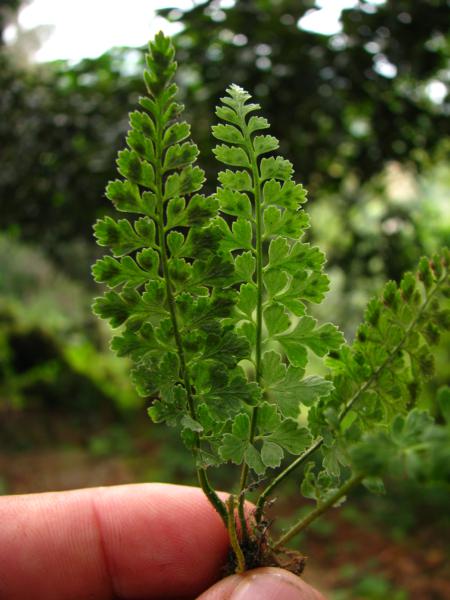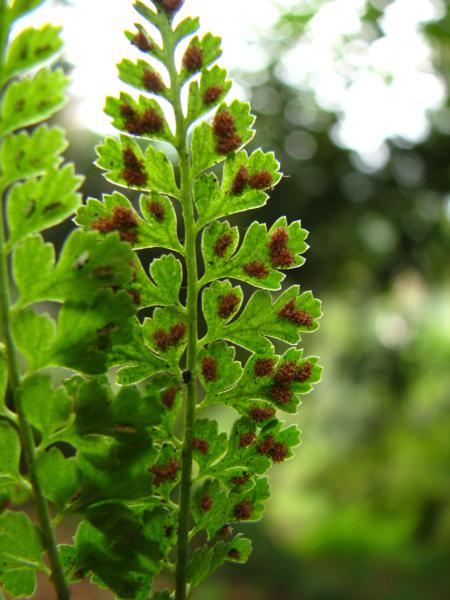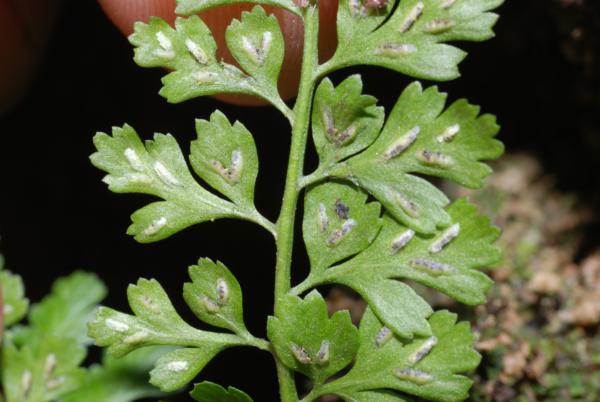
Asplenium laciniatum D.Don
Family
Aspleniaceae
Nomenclature
Asplenium laciniatum D.Don, Prodr. Fl. Nepal.: 8. 1825; Khullar, Ill. Fern Fl. W. Himalaya: 418. 1994. – Type: Wallich, Nepal, "In alpibus" (holotype BM, Morton photograph 6686).
Asplenium varians Wall. ex Hook. & Grev., Icon. Filic.: t. 172. 1829; Bedd., Handb. Ferns Brit. India: 158. 1883; Tardieu & C.Chr., Fl. Indo-Chine 7(2): 235. 1940; Tagawa & K.Iwats., SouthE. Asian Stud. 5: 88. 1967; Tagawa & K.Iwats., Fl. Thailand 3: 276. 1985; Boonkerd & Pollawatn, Pterid. Thailand: 179. 2000.
Description
Lithophytic. Rhizome short, erect, bearing fronds in a tuft; scales narrowly elliptic, gradually narrowing towards apex, about 3.5 by 0.5 mm, dark brown, clathrate, entire. Stipes castaneous, or stramineous upwards, glabrous or scaley, grooved above, 2–3 cm long. Laminae oblong-subdeltoid, acute at apex, about 5 by 3 cm at base, bipinnatifid; rachis green, grooved above, glabrous; pinnae shortly stalked, with 3–6 segments below indistinctly dissected apical portion, about 2 by 1 cm; ultimate segments spathulate, round and toothed at apex, cuneate at base, herbaceous, green, glabrous; veins visible, each entering a tooth of ultimate segments. Sori 2 to 5 for each segment, up to 2 mm long, hardly confluent to each other; indusia enrolling the sori, thin but firm .
Distribution in Thailand
NORTHERN: Chiang Mai.
Wider Distribution
S. Africa, Sri Lanka, India, Himalaya, China, Indochina, Japan and Hawaii.
Ecology
In moist muddy crevices of mossy limestone cliffs in dense forests at 1900– 2000 m.
Similar species
Asplenium exiguum Bedd.
Proposed IUCN Conservation Assessment
Least Concern (LC). This species is widespread and not under any known threats.
Voucher specimens - Thailand
Middleton et al. 5028, Chiang Mai, Doi Ang Khang (E).
Whole plant
Sori
Young sori
Site hosted by the Royal Botanic Garden Edinburgh. Content managed by Stuart Lindsay, Gardens by the Bay, Singapore and David Middleton, Singapore Botanic Gardens. Last updated 24 January 2012


